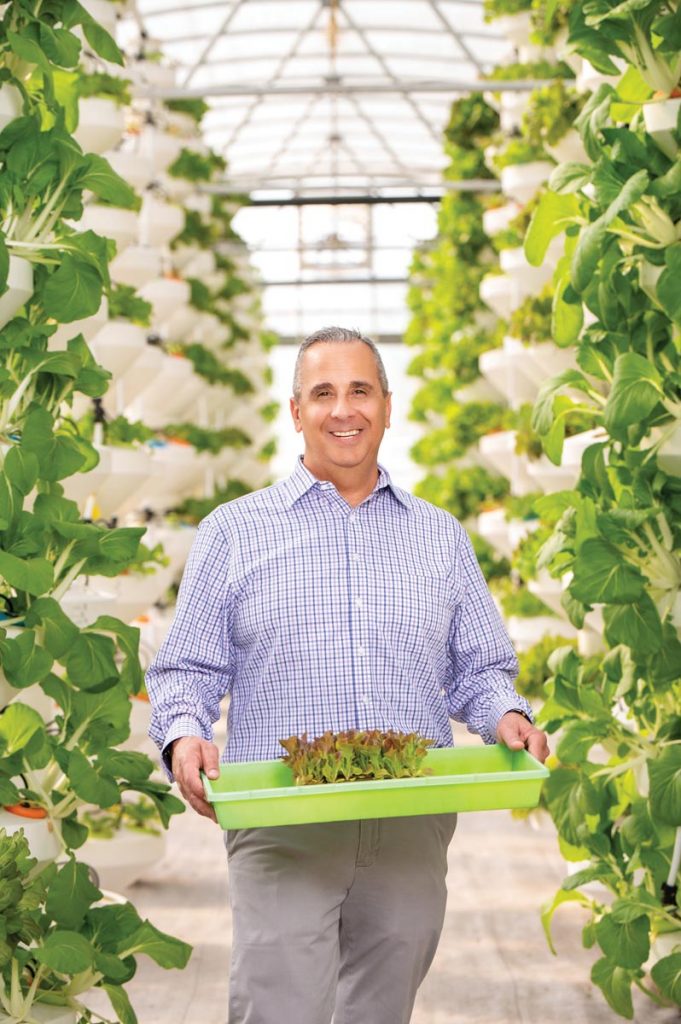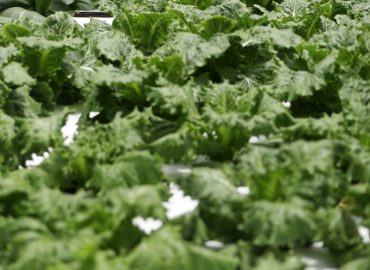Non Profit Hydroponic Farm

Doing Good at Growing Hope Farm
House of Hope’s small farm in Palm City is providing healthy fruits and vegetables to thousands of Martin County residents every month
Non Profit Hydroponic Farm | Valerie Staggs |

Dave Lee believes in the power of the universe. So, in 2018, when the director of food procurement and distribution for Stuart-based nonprofit House of Hope stood on a small parcel of land just off Southwest Martin Highway in Palm City, he knew right away that the universe would deliver what House of Hope desperately needed. “We need a farm,” Lee uttered to CEO Robert Ranieri, who was standing beside him.

Five years later, Lee has transformed that parcel of land into a sustainable farm that provides fresh produce to House of Hope’s four food pantries as well as 30 partner agencies that feed food-insecure residents throughout Martin County. The farm, which stands on a little less than an acre, is just one more piece of the puzzle Lee and Ranieri are trying to solve in their mission of empowering Martin County residents to overcome hunger and hardship.
Founded in 1984 by a small group of volunteers who served hot meals out of their homes and handed out sandwiches to people on the street, House of Hope has grown into a multifaceted nonprofit that serves more than 12,000 local adults and children every month. The handful of volunteers that started the organization has grown exponentially: Last year, 864 volunteers dedicated more than 40,000 hours to House of Hope. Today, the organization’s services range from assistance with food, clothing, and finances to enrichment centers, educational programs, and workforce development. “Everything touches the next thing,” Ranieri says of the multitude of programs House of Hope offers. “We’re trying to be a comprehensive solution for people.”

The farm, aptly named Growing Hope Farm, fills in a gap that Ranieri and Lee had noticed in their food-distribution system. “We couldn’t get fresh produce,” explains Lee, noting that prior to starting the farm, the donated produce their food pantries received was often several days old and past its prime. When House of Hope obtained the land, Lee, a Palm City resident who is the son of a commercial beekeeper, knew just how to maximize production on the small lot: hydroponic and aeroponic growing.

He set about constructing two 3,000-square-foot greenhouses to accommodate hydroponic and aeroponic farming of produce so the nonprofit could get everything it needed in-house. “We produce 1,800 pounds of lettuce a week,” says Lee as he wanders through the aeroponic greenhouse where 72 towers host 66 plants each, overseen by three employees and 30 volunteers. Bright green lettuce in varieties well beyond those found in the average grocery store share tower space with fresh basil, peppers, and bok choy. “Some of our clients didn’t even know what bok choy was,” Lee adds, noting that now people regularly request more of it.
Next door in the hydroponic greenhouse, tomatoes, eggplants, cucumbers, and peppers grow in colorful rows, their tendrils climbing toward the roof. Although these are harvested twice a week, more production is still needed. A third greenhouse is now in the works.

Behind the greenhouses, traditional in-ground farming also produces weekly crops. Cabbage, broccoli, and collards are just a few of the vegetables grown here, while a grove of around 75 fruit trees produce papayas, bananas, avocados, mangoes, cherries, and mulberries.

While the farm has helped bring fresh fruits and vegetables to House of Hope clients, Lee and Ranieri recognize that this is just one part of a much larger picture. “The thing about food banking is that it doesn’t really solve the problem,” says Lee, noting that while the number of food banks nationwide has grown, the nation’s poverty rate is largely unchanged. “Now the focus is on ways to bring people out of poverty.”
Ranieri stresses that the path to empowering people out of poverty is more complex than just providing them with food. “A common obstacle for our clients is health,” he says, pointing to the lack of education about nutrition in schools and the rising levels of obesity and health issues like diabetes that often stem from poor nutrition. The need for nutrition education has spawned a host of programs at House of Hope that are focused on raising awareness about healthy eating and teaching the skills needed to choose and prepare healthy food.

“We made a shift from not just feeding people but feeding them well,” says Lauren Mustelier, director of enrichment and engagement. Mustelier oversees House of Hope’s enrichment programs, which range from early learning and mindfulness to free computer classes and women’s art programs. Nutritional education has become a key focus for Mustelier. “We like to say healthy adults are better earners, and healthy children are better learners,” she says.

In addition to providing for basic needs through its food pantries, House of Hope operates four “nutrition gardens” in the county. When Mustelier found herself fielding requests for even more gardens, House of Hope partnered with a local engineering program to build a “traveling education garden.” This garden on wheels visits local schools, churches, and special events, where staff members demonstrate hands-on gardening and provide information on healthy nutrition and where food comes from. “Often kids dictate what is eaten at home,” says Mustelier. “I’m always surprised just how much more likely they are to try new foods when they’ve helped grow them.”
Choosing good foods is important, but knowing how to prepare them is crucial too. To that end, House of Hope offers nutrition and wellness programs at its enrichment center focused on how to create healthy meals, which includes basic cooking skills. During the summer months, the center also hosts a teen cooking program.

This summer, House of Hope will expand its services once more, launching a produce prescription program in partnership with Cleveland Clinic. Physicians at Cleveland Clinic who care for patients with health issues such as diabetes will be able to write a prescription for nutritious foods that these patients should include in their diets—and House of Hope will work with patients to provide these foods and educate them on how to prepare them.

Meanwhile, back at the farm, expansion plans are underway. Lee is transforming an on-site building into a packing house to eliminate the need for trucking produce to House of Hope’s nutrition and wellness center (where it is currently being washed and packaged for distribution). Just steps away from the farm’s greenhouses and gardens, the facility will make it easier and quicker to get fresh produce ready for distribution. Inside the building, Lee shows off a shiny new produce submersion washer, a large machine that thoroughly cleans produce in bulk. “It’s like a Jacuzzi for food,” he says with a smile. Nearby is a giant salad spinner, where 200 pounds of lettuce can be tossed at once.
The innovation of the House of Hope team has not gone unnoticed. Agencies from all over the country have visited the organization to find out more about the creative approaches they are taking to address poverty. While the impact of their programs has been significant—in fiscal year 2021-2022, House of Hope distributed 1.5 million pounds of food to the community—a lot more is still needed.

According to the latest ALICE Report completed in 2018 (which measures the number of families who are struggling financially in a given area, among other things), 11 percent of households in Martin County are living in poverty. Ranieri says the numbers have grown since COVID: “We served about 4,000 clients a month before the pandemic. Now we serve about 7,000 a month directly and another 5,000 a month through food programs.”
For Ranieri, whose farming experience prior to Growing Hope Farm boiled down to “watering my grandma’s tomato plants when I was a kid,” the success of House of Hope really stems from the community’s dedication. “We are thankful to live in a very generous community,” he says.
Original Article: https://www.stuartmagazine.com/stuart-life/health-wellness/doing-good-at-growing-hope-farm/
The post Non Profit Hydroponic Farm appeared first on GROZINE.


